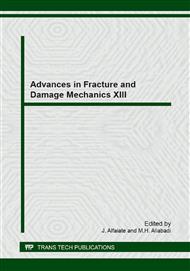p.77
p.81
p.85
p.89
p.93
p.97
p.101
p.105
p.109
Evaluation by FEM of the Influence of the Preheating and Post-Heating Treatments on Residual Stresses in Welding
Abstract:
During the last few years various experimental destructive and non-destructive methods were developed to evaluate residual stresses. However it is impossible to obtain a full residual stress distribution in welded structures by means of experimental methods. This disadvantage can be solved by means of computational analysis which allows to determine the whole stress and strain fields in complex structures. In this paper the temperature distribution and residual stresses were determined in a single-pass butt joint welded by GMAW (Gas Metal Arc Welding) process by finite element model (FEM). A 3D finite parametric element model has been carried out to analyze temperature distribution in butt weld joints and thermo-mechanical analyses were performed to evaluate resulting residual stresses. Temperature fields have been investigated by varying an initial preheating treatment. Moreover the technique of “element birth and death” was adopted to simulate the process of filler metal addition The high stresses were evaluated, with particular regard to fusion zone and heat affected zone. The influence of preheating and post-heating treatment on residual stresses was investigated. The residual stresses decrease when preheating temperature increases. The maximum value of longitudinal residual stresses without pre-heating can be reduced about 12% and 38% by using the preheating and post-heating process respectively.
Info:
Periodical:
Pages:
93-96
Citation:
Online since:
September 2014
Authors:
Keywords:
Price:
Сopyright:
© 2015 Trans Tech Publications Ltd. All Rights Reserved
Share:
Citation:


